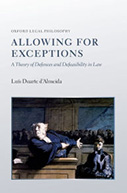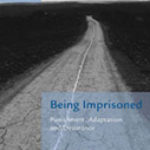Allowing For Exceptions – A Theory Of Defences And Defeasibility In Law

Author: Luís Duarte d’Almeida
Publisher: Oxford, UK: Oxford University Press, 2015. 320p.
Reviewer: Kyriakos N. Kotsoglou | March 2017
Modern legal systems are criss-crossed with exceptions. Someone who confesses his wrongdoing will not be convicted if he brings an effective defence into play. Yet while we in practice can cope with these situations easily enough, we seem to lack a theoretical understanding of legal exceptions. As with any other practical ability, we can give hints and rules of thumb for the practice of exceptions; but this practice seemingly cannot be systematised or reduced to a set of rules. Not only do we routinely depart from general rules (e.g. ‘You ought not to kill’) by allowing exceptions – depriving the law of one of its genetic elements, i.e. its generality – but we do so in uncontrolled, theoretically questionable and perhaps unwarranted ways. The lack of a synoptic view of legal exceptions is alarming.
In this recent monograph, Luís Duarte d’Almeida undertakes the important and timely task of examining how the role of exceptions in judicial decision-making is to be understood (p. 4). He stresses that our understanding of exceptions cannot depend on “contingent matter[s]” such as the policy-maker’s decision “whether the negation of some given fact x is classified by law as an offence-element, or x is classified as a defence instead’” (p. 6). We need, so the argument goes, an understanding of what is essential about (legal) exceptions. Duarte d’Almeida’s plan is to offer “a novel account of defeasibility in law” (p. 21) – a concept, which is all the rage in jurisprudence and analytic philosophy. Quite naturally, he revisits H.L.A. Hart’s influential but later retracted paper “The Ascription of Responsibility and Rights”, which spawned both the concept and the term ‘defeasibility’. Hart had stumbled on a peculiarity of legal rules, where the central component is the word “unless”. This conjunction, Hart remarked, has the function of rebutting a claim, i.e. introducing an exception. There is no glory in criticizing a repudiated paper. Duarte d’Almeida senses nevertheless that ‘defeasibility’ could provide us with the key for solving our problems. In the first part of his book (‘Defeasibility in question’, ch. 1-2) he tries to dig deeper and excavate Hart’s substantial claim, characterized as the “irreducibility thesis” (p. 13-22), according to which defeating circumstances (exceptions) are not reducible to necessary conditions of correct judgments (p. 17). Before proceeding to address the irreducibility thesis, the author ‘filters the noise’ surrounding defeasibility. He explains that the notion of a defeasible judgement, in the legal field or elsewhere, is not intrinsically connected to non-finality (‘defeasibleNF’). For fallibility does not seem to encapsulate the main function of defeasible concepts, namely to rebut certain claims. We therefore need an account of defeasibility proper (“defeasiblep”, pp. 27-28).
In the second part of the book (“Defeasibility in theory”), Duarte d’Almeida starts to construct his own model. In order to make sense of the ‘irreducibility thesis’, Chapters 3-6 engage with the current debate on legal exceptions between incorporationists (who claim that the negation of each admissible exception is itself a condition of a correct decision) and non-deductivists (who stress the non-monotonic character of legal reasoning). Duarte d’Almeida sensibly rejects both, as resting on a fallacious presupposition: the specification of positive and negative conditions for a (correct) legal decision. Positive elements of, say, a crime (P-facts) and the possible legal exceptions to it (D-facts) are, in reality, contingent on legislative intent. Any element of a legal prescription could be drafted as either a positive or a negative condition. For Duarte d’Almeida, neither the picture of D-facts as necessary conditions of decisions nor the abandonment of the logico-mechanical model of deductive legal reasoning offers an attractive response to this predicament.
Meaningful discussion of D-facts is contingent upon their being irreducible to P-facts. Duarte d’Almeida must show that these two propositional sets behave in different ways. According to the received view propounding the “substantive representation” (p. 58), both P-facts and D-facts either depict a true state of the world or they do not. Duarte d’Almeida argues that this flawed substantive approach will not get us far in a legal procedural context. Legal adjudication involves procedurally structured reasoning under uncertainty. Probative evidence establishes guilt or liability, not the other way around. Duarte d’Almeida observes that P-facts and D-facts follow the same grammatical rules, but only if we examine them from a substantive perspective, which excludes uncertainty. Therefore, we have to change our perspective and operate not with absolute facts, such as X – which can only be either true or false – but with the following fourfold range of epistemic possibilities: 1) X is proved, 2) not-X is proved, 3) X is not proved, and 4) not-X is not proved (p. 53). Introducing the “proof-based account” (p. 52) is a decisive move. Read against this matrix, the idea that the absence of a P-fact is radically different from the absence of a D-fact seems utterly convincing (p. 74). For defeasible decisions, Duarte d’Almeida reminds us, are decisions “that depend not on the ascertainment, to any standard, of the non-occurrence of exceptions, but on the non-ascertainment, to a given standard, of their occurrence” (p. 184 and ch. 6).
In Chapter 4, Duarte d’Almeida addresses possible criticisms of his model deriving from doctrinal analysis on burdens of proof. He manages – I think – to silence these arguments effectively by stressing that the burden of proof is about procedural tactics. Strictly speaking, he writes, there is “no legal obligation for any procedural party to ‘discharge’ her burden” (p. 89). In Chapter 5, the author examines the problem of “implicit exceptions”, where we seemingly have a gap between the rules and their application because there is no explicitly formulated list of circumstances that classify as exceptions under a certain provision.
The third part of the book is titled “Defeasibility in Action” (chs. 7-8) and provides a survey of some possible applications of the model. Duarte d’Almeida wants to “put the proof-based account to the test” (p. 187). His first target is the interplay of accusations and answers in extra-legal, everyday contexts (ch. 7). For example, “A did φ” can be answered in two different ways: either by denying the allegations or by offering an excuse or justification. Most importantly, we do not have to rule out all possible defeaters in order to accuse someone (p. 194). In Chapter 8, Duarte d’Almeida returns to legal contexts. First, he reads the results of his model against the doctrinal analysis of the German concept of crime and its tripartite analysis of criminal liability (pp. 219-233). Second, he endeavours to cast light on the doctrinal distinction between offences and defences.
Having discussed its virtues, I will now draw attention to some of the book’s shortcomings. Duarte d’Almeida aspires to describe the judge’s activity in logico-mechanical terms. Given the author’s commitment to deductive inferences and necessity of conclusions, and given that only formal logic could support such a machinery, it remains unanswered: a) which model of formal logic would or could support these inferences; and b) how the model could deal with semantics and the indeterminacy of (legal) language. Either a model is a closed system based on logical deduction (but then one has to apply the grammar of formal languages and eliminate linguistic indeterminacy), or a model is not a closed system and thus precludes deductive inferences.
Duarte d’Almeida attempts to build a new theory of defeasibility pretty much from scratch. The foundation of default logic (Reiter 1980), which provides formal methods and supports exactly this kind of reasoning, does not receive Duarte d’Almeida’s attention. If economy of thought is a methodological axiom, this omission should be troubling. There is no need to coin new phrases such as ‘ceteris ignotis’ (p. 171) or build a new theory, since Reiter’s default logic already provides a theoretical framework for ‘jumping to conclusions’ in the absence of information. The inference pattern “in the absence of any information to the contrary, assume …” (Reiter, 1980:81) is an accurate description of the syntax of legal exceptions, too. Furthermore, it is doubtful whether the distinction between implicit and explicit exceptions is meaningful. Even for ‘explicit’ exceptions we must anticipate situations in which new, previously unanswered questions arise. Rules in general can never dictate their own application. The extra mile the judge has to go when facing ‘implicit’ exceptions arises from the semantics of the legal norms stipulating exceptions – not from the cardinality of the set of cognisable exceptions.
Viewed in broader perspective, the book raises fundamental questions about intradisciplinary and comparative research in law. Duarte d’Almeida reads his model against the tripartite analysis of ‘crime’ in German criminal law. The German model, he suggests, classifies legal wrongfulness as “some other definitional ‘element’” (p. 229), namely as something “that must be ‘present’, in order to assert a crime” (p. 228). The superimposition of the theoretical tripartite analysis on the actual dichotomy between P-facts and D-facts – “which the model ignores” (p. 229) – creates, so the argument goes, an unsustainable asymmetry between theory and procedural practice, a Kuhnian anomaly, which under normal circumstances should force theorists to give up on the model. However, Duarte d’Almeida seems to ignore that legal wrongfulness is not just a theoretical term, exclusively serving purposes of logical systematisation of the law. Legal wrongfulness is much more than that, since it is an integral part of the law itself. For example, the culpability of the secondary parties will be examined only if the act of the perpetrator is “legally wrongful” (§§ 26, 27 German Penal Code). The ‘German model’ is constituted by this institutional/legislative fact. The tripartite analysis of ‘crime’ does not, in fact, prevent us from applying a defeasible structure for the ascertainment of legal wrongfulness and culpability. On the contrary, it allows us to ‘jump’ to defeasible conclusions in more differentiated, and indeed: elegant, ways, triggering a range of doctrinal legal consequences.
In summary, ‘Allowing for Exceptions’ is a challenging book, argued with clarity and rigour, which presents a masterful exposition of an area of law defeasibly(!) at play in every legal case. Besides able discussion of a theoretical conundrum and painstaking attention to detail, the most notable feature of Duarte d’Almeida’s approach is his aspiration to root judicial practice in fundamental principles of legal theory. Although Duarte d’Almeida’s model suffers, I believe, from various shortcomings, his efforts will nonetheless reward careful study.
Kyriakos N. Kotsoglou, Liverpool/UK
- L. A. Hart, ‘The Ascription of Responsibility and Rights’ (1949), 49 Proceedings of the Aristotelian Society: 171–194
- Reiter, ‘A Logic for Default Reasoning’, in: 13 Artificial Intelligence (1980), pp. 81–132 (94).


